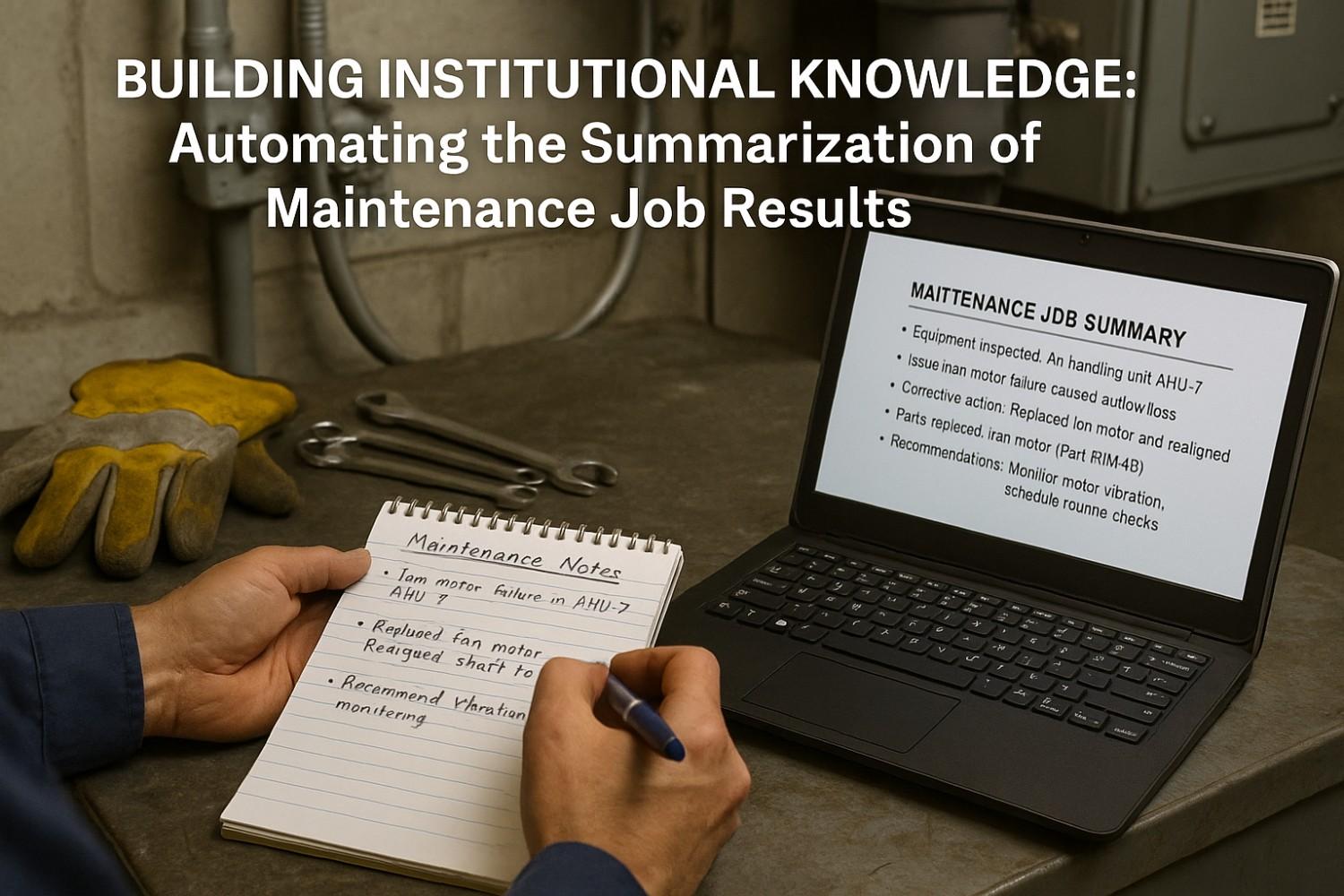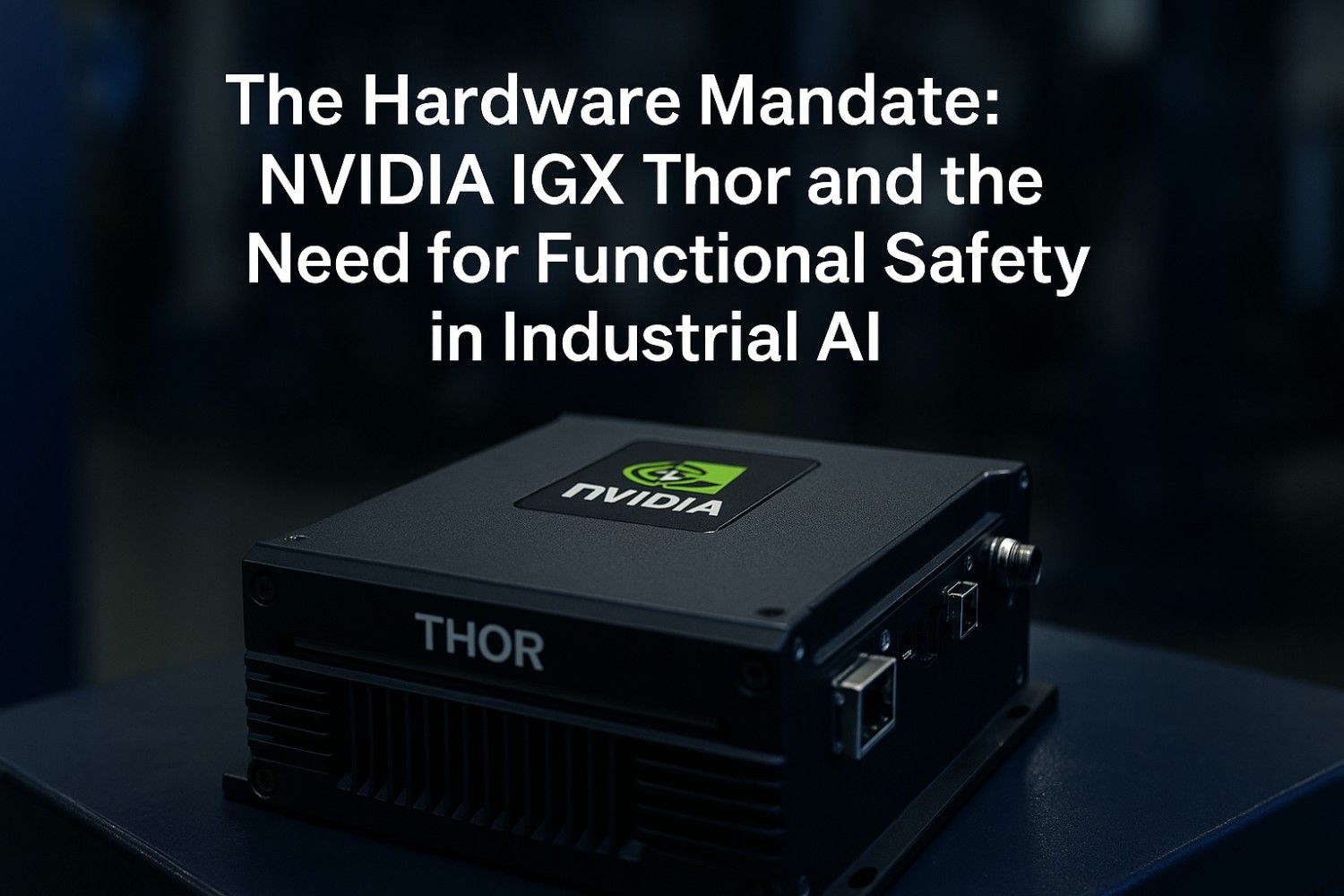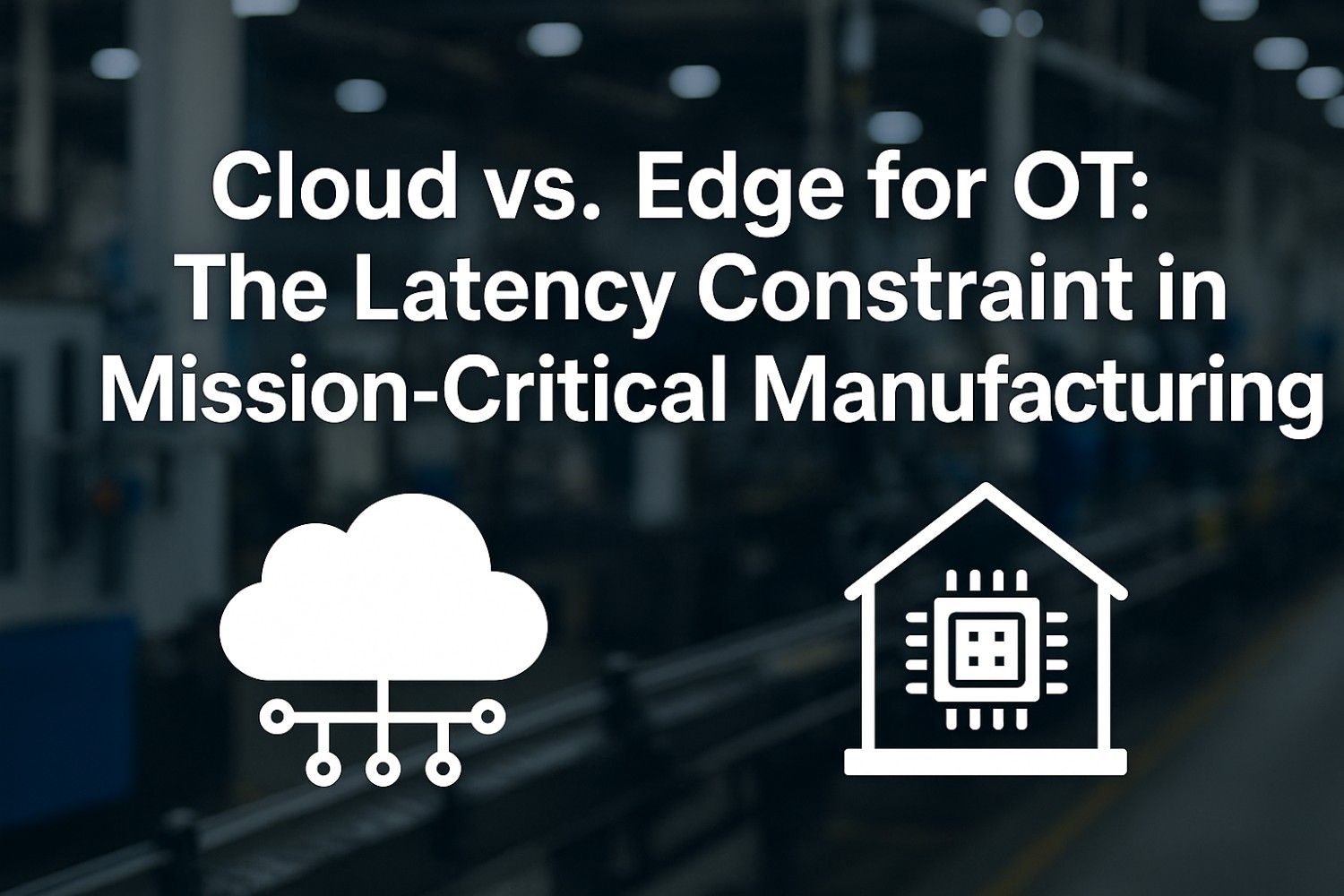Your most experienced technician walks into your office with retirement papers: "I'm done in 90 days." In that moment, you realize 28 years of troubleshooting expertise, undocumented workarounds, and field-tested solutions will walk out the door with him. You frantically review technician notes from the past year—cryptic abbreviations, incomplete observations, photos without context—impossible to transform into institutional knowledge that could train his replacement. Without automated knowledge capture systems and AI-driven summarization, you're hemorrhaging decades of maintenance expertise with every retirement, resignation, and crew transfer.
This knowledge crisis unfolds across American manufacturing facilities as experienced technicians retire faster than organizations can capture their expertise. The average industrial facility loses 15-25% of its institutional maintenance knowledge annually through workforce turnover, yet only 12-18% of technician field observations ever become searchable, reusable knowledge. Organizations implementing AI-powered knowledge capture can preserve 80-95% of field expertise through automated technician note summarization and continuous learning loops.
Facilities deploying LLM-driven knowledge capture systems achieve 60-75% faster problem resolution for recurring issues while reducing training time for new technicians by 40-55% compared to traditional manual documentation approaches. The transformation lies in leveraging large language models that automatically convert unstructured technician notes, photos, and observations into structured, searchable institutional knowledge that continuously improves maintenance effectiveness.
Stop losing maintenance expertise when experienced technicians retire—automate knowledge capture from every work order and preserve your institutional intelligence permanently.
Imagine capturing 28 years of troubleshooting expertise automatically, making it instantly searchable for your entire team. Transform cryptic technician notes into structured knowledge that trains the next generation while your veterans are still on the floor.
The Cost of Losing Institutional Knowledge
Understanding the financial and operational impact of knowledge loss requires examining the hidden costs that accumulate when technician expertise disappears from organizations. These costs extend far beyond obvious training expenses to include repeated equipment failures, extended downtime, and safety incidents that occur when critical troubleshooting knowledge vanishes with departing employees.
Traditional maintenance documentation captures only 10-15% of actual technician knowledge, with most field observations remaining locked in individual memories or scattered across handwritten notes, text messages, and verbal conversations. When experienced technicians leave, facilities typically experience 25-40% increases in mean time to repair (MTTR) for the first 6-12 months as remaining staff rediscover solutions through trial and error.
Knowledge Preservation Challenges
The fundamental challenge in knowledge preservation stems from the gap between technician field experience and formal documentation systems. Technicians solving complex problems in real-time rarely have the time, training, or incentive to document their observations in formats that become reusable institutional knowledge.
Retirement-Driven Knowledge Loss
Baby boomer retirements remove 20-30 years of average maintenance experience. Facilities lose critical equipment-specific knowledge, historical failure patterns, and proven workarounds that took decades to develop.
Documentation Time Constraints
Technicians spend 85-90% of time on reactive repairs, leaving only 10-15% for documentation. Manual knowledge capture competes directly with productive maintenance work, creating systematic under-documentation.
Unstructured Information Capture
Field observations captured as free-text notes, photos, or verbal handoffs. Without structured formats, this information remains unsearchable and unusable for training or future troubleshooting.
Knowledge Siloing by Shift/Crew
Critical troubleshooting insights remain with individual technicians or specific crews. Knowledge never transfers between shifts, creating duplicate problem-solving efforts and inconsistent repair approaches.
The economic impact of knowledge loss manifests in measurable maintenance performance degradation. Facilities experiencing significant technician turnover typically see 30-45% increases in emergency repair costs, 20-35% higher spare parts consumption, and 15-25% longer equipment downtime as remaining staff rediscover solutions through expensive trial-and-error approaches.
From Technician Notes to Institutional Intelligence: Live LLM Knowledge Capture Demo
See how local AI deployments automatically transform scattered technician notes into searchable institutional knowledge—processing thousands of observations in seconds while keeping your proprietary maintenance data secure behind your firewall.
November 19 Live Demo: Stop losing expertise when technicians retire. Every job automatically summarized, searchable, and ready for your next team member.
Register for Live DemoAutomating Technician Note Summarization
Implementing effective automated knowledge capture requires understanding the AI-powered systems that transform unstructured technician observations into structured, searchable institutional knowledge. Large language models excel at extracting key information from incomplete notes, identifying patterns across multiple work orders, and generating standardized summaries that preserve critical troubleshooting steps and solutions.
Modern LLM-driven summarization systems process technician notes in real-time, automatically extracting equipment identifiers, failure symptoms, root causes, corrective actions, and lessons learned. These systems achieve 85-95% accuracy in information extraction while reducing documentation burden on technicians from 15-20 minutes per work order to zero active documentation time.
Manual vs. Automated Summarization
The transformation from manual to automated knowledge capture fundamentally changes maintenance documentation economics. Manual approaches require technicians to spend significant time converting field observations into structured documentation, creating friction that results in systematic under-documentation and knowledge loss.
| Knowledge Capture Method | Tech Time Required | Capture Rate | Knowledge Quality |
|---|---|---|---|
| Manual Documentation | 15-20 min per work order | 10-15% | Inconsistent, often incomplete |
| Structured Forms/Checklists | 8-12 min per work order | 25-35% | Limited to predefined fields |
| Voice-to-Text Capture | 3-5 min per work order | 40-55% | Unstructured, requires cleanup |
| LLM Auto-Summarization | 0 min (automatic) | 80-95% | Structured, standardized, searchable |
Automated summarization systems integrate directly with CMMS work order workflows, processing technician notes as work orders close without requiring additional user input. Advanced implementations incorporate computer vision to analyze uploaded photos, extracting equipment conditions, damage patterns, and visual evidence, that supplement text-based observations.
Photo and Document Integration
Visual documentation represents 60-75% of valuable field knowledge that traditional text-based systems fail to capture. LLM-powered knowledge capture systems with integrated computer vision analyze technician photos to identify equipment conditions, damage patterns, proper repair techniques, and installation configurations that become searchable components of institutional knowledge.
The most advanced knowledge capture platforms create multi-modal knowledge representations combining text summaries, annotated photos, equipment hierarchies, and failure pattern linkages. These comprehensive knowledge packages provide context that single-source documentation cannot achieve, enabling faster problem diagnosis and more effective training for new technicians.
Building a Living Knowledge Base
Creating sustainable institutional knowledge requires more than capturing individual work orders—it demands systematic knowledge base architecture that continuously organizes, updates, and surfaces relevant information when technicians need it. Living knowledge bases differ fundamentally from static documentation by automatically identifying knowledge patterns, detecting outdated information, and suggesting knowledge updates based on recent field observations.
Effective knowledge base systems organize captured information across multiple dimensions: equipment hierarchy, failure modes, symptom patterns, repair procedures, and parts requirements. This multi-dimensional organization enables technicians to find relevant knowledge through equipment searches, symptom descriptions, or problem characteristics rather than relying on exact keyword matches.
Knowledge Base Versioning Strategy
Maintaining knowledge currency requires systematic versioning that tracks how solutions evolve over time while preserving historical context. Equipment modifications, process changes, and new troubleshooting techniques constantly update best practices, yet many facilities struggle to keep documentation aligned with current reality.
Knowledge Base Development Process
Version control mechanisms track knowledge evolution while maintaining access to historical solutions that may become relevant again after equipment modifications or process reversions. Advanced systems automatically flag knowledge that hasn't been validated recently, prompting periodic review to ensure continued accuracy and relevance.
Technician Access to Historical Solutions
Knowledge value depends entirely on accessibility when technicians need information during active troubleshooting. The most sophisticated knowledge bases integrate directly into technician workflows, automatically surfacing relevant historical solutions based on current equipment, symptoms, and work order context without requiring explicit searches.
Knowledge Access Optimization Strategies
- Implement mobile-first interfaces enabling field access to knowledge base from any device or location
- Deploy context-aware knowledge suggestions automatically surfacing relevant solutions during work order execution
- Create equipment-specific knowledge cards consolidating all captured expertise for individual assets
- Enable natural language search allowing technicians to describe problems conversationally
- Build visual search capabilities finding similar problems through photo matching
- Integrate knowledge access directly into CMMS work order screens eliminating separate application navigation
- Develop offline knowledge access for facilities with limited network connectivity
Continuous Learning Loops in Maintenance
Transforming captured knowledge into operational excellence requires establishing continuous learning loops that systematically identify improvement opportunities, implement proven solutions facility-wide, and measure knowledge impact on maintenance performance. These learning loops convert individual problem-solving successes into standardized best practices while continuously refining procedures based on field results.
Effective learning loops operate at multiple organizational levels: individual technician skill development, crew-level problem-solving capability, facility-wide procedure optimization, and enterprise maintenance strategy refinement. Each loop operates on different timescales but contributes to cumulative maintenance performance improvements.
System Learning Improvement Cycle
System-level learning requires analytical capabilities that identify patterns across thousands of work orders, detecting recurring problems, quantifying solution effectiveness, and recommending proactive improvements. AI-powered analytics excel at discovering these patterns, often identifying optimization opportunities invisible to traditional management review processes.
2025 Knowledge Capture Trends Transforming Maintenance
- Generative AI creating interactive troubleshooting guides from captured work order patterns
- Real-time knowledge validation through IoT sensor data confirming repair effectiveness
- Augmented reality overlays displaying relevant historical knowledge on equipment during repairs
- Predictive knowledge surfacing anticipating which information technicians will need next
- Cross-facility knowledge sharing identifying solutions from similar equipment across enterprise
- Automated training content generation converting field knowledge into structured learning modules
Learning loop effectiveness depends on systematic measurement connecting knowledge utilization to maintenance outcomes. Leading facilities track metrics like knowledge reference rates, solution reuse frequency, time-to-resolution improvements, and training acceleration to quantify knowledge capture ROI and identify knowledge gaps requiring additional focus.
The most mature learning loops incorporate external knowledge sources, integrating manufacturer technical bulletins, industry best practices, and vendor recommendations alongside internal field experience. This comprehensive knowledge synthesis ensures technicians access the best available information regardless of whether solutions originated internally or externally.
Preserving Real-World Solutions
The ultimate value of automated knowledge capture emerges in preserving real-world problem-solving approaches that reflect actual facility conditions, equipment configurations, and operational constraints. These field-proven solutions often differ significantly from manufacturer recommendations or textbook procedures, representing invaluable adaptations developed through years of hands-on experience with specific equipment in specific operating environments.
Real-world solution preservation requires capturing not just what worked, but why solutions succeeded, what alternatives were attempted, and what conditions influenced approach selection. This contextual information transforms simple repair records into educational experiences that accelerate problem-solving skills for less experienced technicians.
Equipment-Specific Adaptations
Capture modifications and workarounds developed for aging or non-standard equipment. Preserve critical knowledge about equipment quirks, failure precursors, and repair techniques specific to your facility's unique asset base.
Troubleshooting Decision Trees
Document diagnostic logic experienced technicians use instinctively. Convert tacit knowledge about symptom interpretation and diagnostic sequencing into structured decision support for less experienced staff.
Safety Lessons and Near-Misses
Systematically capture safety insights from field experiences including near-miss incidents and lessons learned. Prevent future incidents by making safety knowledge immediately searchable and actionable.
Vendor and Contractor Intelligence
Preserve knowledge about vendor capabilities, contractor reliability, and external expertise access. Build institutional memory about which external resources solve which problems most effectively.
Solution effectiveness tracking provides critical feedback demonstrating which captured knowledge delivers actual value. Advanced knowledge systems automatically track when technicians reference specific knowledge articles, measure time-to-resolution improvements, and identify most valuable knowledge contributors to focus future capture efforts on highest-impact information sources.
The competitive advantage from comprehensive knowledge preservation compounds over time as facilities build knowledge assets competitors cannot easily replicate. Organizations with 5+ years of systematically captured maintenance knowledge develop troubleshooting capabilities that deliver 2-3x faster problem resolution and 40-50% higher first-time fix rates than industry averages.
Conclusion
Automated knowledge capture through LLM-driven technician note summarization represents the most significant advancement in maintenance knowledge management since computerized maintenance systems emerged decades ago. Organizations implementing AI-powered knowledge capture preserve 80-95% of field expertise while reducing new technician training time by 40-55% through systematic conversion of unstructured observations into structured, searchable institutional knowledge.
Understanding knowledge loss economics reveals that each retiring technician with 20+ years experience takes $800,000-1.2 million in undocumented troubleshooting expertise when they leave. Manual documentation approaches capture only 10-15% of actual technician knowledge due to time constraints and documentation friction, creating systematic knowledge hemorrhaging that damages maintenance effectiveness across entire careers.
Automated summarization systems eliminate documentation burden while achieving 80-95% knowledge capture rates through real-time processing of technician notes, photos, and observations. These systems transform unstructured field information into standardized, searchable knowledge packages that preserve critical troubleshooting context, proven solutions, and equipment-specific adaptations.
Building living knowledge bases requires systematic architecture organizing captured information across equipment hierarchies, failure modes, and symptom patterns while maintaining version control and accessibility during active troubleshooting. Knowledge value depends entirely on seamless workflow integration that surfaces relevant information automatically when technicians need it most.
Continuous learning loops transform individual problem-solving successes into facility-wide best practices through pattern recognition, solution standardization, and systematic performance measurement. The most mature implementations leverage multi-year knowledge assets to develop troubleshooting capabilities delivering 2-3x faster problem resolution than competitors relying on individual technician experience.
The 2025 competitive environment increasingly rewards organizations preserving and leveraging institutional knowledge while penalizing those losing expertise through workforce turnover. Success requires immediate implementation of automated knowledge capture systems that begin building institutional intelligence before your next retirement announcement creates irreversible knowledge loss.
Transform technician notes into institutional knowledge automatically—preserve decades of expertise and slash training time before your veterans retire.
Every work order your team completes contains valuable knowledge that could train future technicians and prevent recurring failures. Stop losing this expertise to turnover and retirements. Start capturing it automatically today, building a knowledge asset that compounds in value every single day and makes your entire team as effective as your best veteran technician.







.jpeg)

